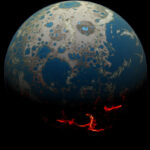NASA’s Parker Solar Probe has flown close enough to the Sun to detect the fine structure of the solar wind close to where it is generated at the solar surface, revealing details that are lost as the wind exits the solar corona as a uniform blast of charged particles.
Parker Solar Probe has flown through the solar corona and sampled particles and magnetic fields there. Image credit: NASA’s Goddard Space Flight Center.
The solar wind forms the heliosphere, a giant magnetic bubble that protects planets in our Solar System from a barrage of high-energy cosmic rays.
However, the solar wind also carries plasma and part of the Sun’s magnetic field, which can crash into Earth’s magnetosphere and cause disturbances, including geomagnetic storms.
These storms occur when the Sun experiences more turbulent activity, including solar flares and enormous expulsions of plasma into space, known as coronal mass ejections.
Geomagnetic storms are responsible for spectacular aurora light shows that can be seen near the Earth’s poles, but at their most powerful, they can knock out a city’s power grid and potentially even disrupt global communications.
Previous studies revealed that the Sun’s magnetic field was somehow driving the solar wind, but researchers didn’t know the underlying mechanism.
In an earlier paper, University of Maryland’s Professor James Drake and colleagues argued that the heating and acceleration of the solar wind is driven by magnetic reconnection.
They explained that the entire surface of the Sun is covered in small jetlets of hot plasma that are propelled upward by magnetic reconnection, which occurs when magnetic fields pointing in opposite directions cross-connect. In turn, this triggers the release of massive amounts of energy.
“Two things pointing in opposite directions often wind up annihilating each other, and in this case doing so releases magnetic energy,” Professor Drake said.
“These explosions that happen on the Sun are all driven by that mechanism. It’s the annihilation of a magnetic field.”
To better understand these processes, the astronomers used data from NASA’s Parker Solar Probe to analyze the plasma flowing out of the solar corona.
In April 2021, Parker Solar Probe became the first spacecraft to enter the corona and has been nudging closer to the Sun ever since.
The data analyzed by Proffesor Drake’s team was taken at a distance of 13 solar radii.
“When you get very close to the Sun, you start seeing stuff that you just can’t see from Earth,” Professor Drake said.
“All the satellites that surround Earth are 210 solar radii from the Sun, and now we’re down to 13. We’re about as close as we’re going to get.”
Using the new data, the authors provided the first characterization of the bursts of magnetic energy that occur in coronal holes, which are openings in the Sun’s magnetic field as well as the source of the solar wind.
They demonstrated that magnetic reconnection between open and closed magnetic fields — known as interchange connection — is a continuous process, rather than a series of isolated events as previously thought.
This led them to conclude that the rate of magnetic energy release, which drives the outward jet of heated plasma, was powerful enough to overcome gravity and produce the Sun’s fast wind.
“The big conclusion is that it’s magnetic reconnection within the funnel structures that’s providing the energy source of the fast solar wind,” said University of California, Berkeley’s Professor Stuart Bale.
“It doesn’t just come from everywhere in a coronal hole, it’s substructured within coronal holes to these supergranulation cells.”
“It comes from these little bundles of magnetic energy that are associated with the convection flows.”
“Our results, we think, are strong evidence that it’s reconnection that’s doing that.”
“Winds are produced by objects throughout the Universe, so understanding what drives the wind from the Sun has broad implications,” Professor Drake said.
“Winds from stars, for example, play a crucial role in shielding planetary systems from galactic cosmic rays, which can impact habitability.”
“This would not only aid our understanding of the Universe, but possibly also the search for life on other planets.”
The findings appear in the journal Nature.
_____
S.D. Bale et al. 2023. Interchange reconnection as the source of the fast solar wind within coronal holes. Nature 618, 252-256; doi: 10.1038/s41586-023-05955-3




